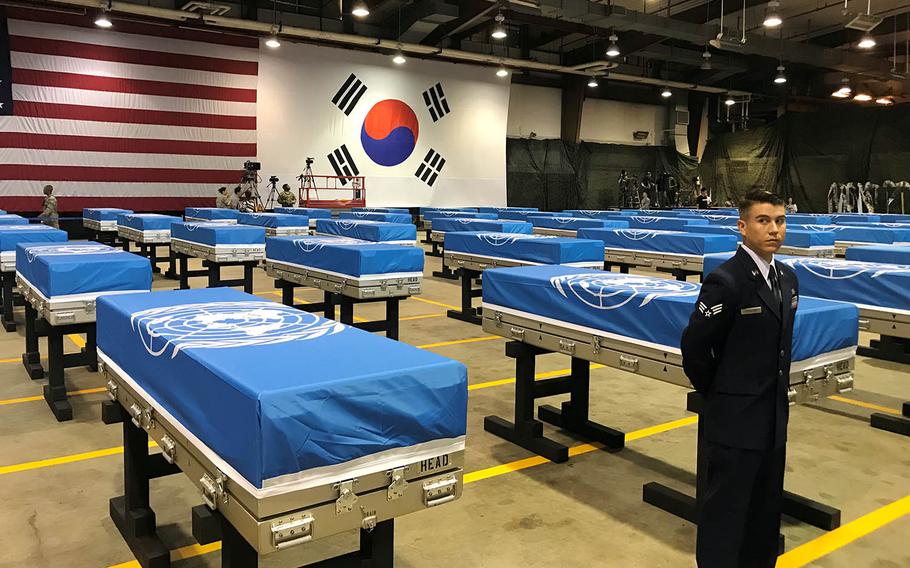
Remains recently handed over by North Korea are seen before a ceremony at Osan Air Base, South Korea, Wednesday, Aug. 1, 2018. (Kim Gamel/Stars and Stripes)
SEOUL, South Korea — At least 41 American troops have been identified among the remains returned from North Korea last year, officials said Friday, paving the way for them to be returned to their families nearly seven decades after the Korean War.
Army Cpl. Lloyd B. Odom, 19, of Odessa, Mo., was the third missing soldier whose identity was announced this week. The Pentagon said Friday that Odom was accounted for on Sept. 12.
North Korea turned over 55 cases of bones and artifacts to the United States in July 2018, weeks after its leader, Kim Jong Un, agreed to do so as a goodwill gesture during his first nuclear summit with President Donald Trump.
One soldier — Army Master Sgt. Charles H. McDaniel, who was killed in 1950 — was quickly identified after his dog tag was included among the remains.
Several more identifications followed, but scientists cautioned that they may need years to confirm the rest using a painstaking process that involves DNA and other forensic tools.
“We are up to 41,” Air Force Lt. Col. Kenneth Hoffman, a spokesman for the Defense Department agency overseeing the effort, told Stars and Stripes in an email. “We can’t speculate at this point about how many more soldiers may be identified.”
Odom, a member of the 7th Infantry Division, 31st Regimental Combat Team, was reported missing in action on Dec. 2, 1950, in the vicinity of the Chosin Reservoir when his unit was attacked by enemy forces in one of the fiercest battles of the three-year war.
Odom will be buried at Arlington National Cemetery, although the date has yet to be determined, according to the Defense POW/MIA Accounting Agency, or DPAA.
A rosette also will be placed next to Odom’s name on the Courts of the Missing at the National Memorial Cemetery of the Pacific in Honolulu.
Earlier this week, the DPAA announced the identification of two other soldiers — Cpl. Charles H. Grubb, 21, of War Eagle, W. Va., and Sgt. James Ernest Smith, 21, of Sedgwick, Kan.
Trump has cited the return of the remains as a sign of progress in his administration’s faltering efforts to persuade the communist state to abandon its nuclear weapons program.
However, hopes that joint searches for more remains in North Korea could resume have been put on hold as diplomacy has stalled.
More than 7,600 Americans remain missing since the 1950-53 war ended in an armistice instead of a peace treaty, leaving the two Koreas divided by one of the world’s most heavily fortified frontiers.
Some 5,300 were believed lost in the North. Some progress in recovering remains was made with joint searches between 1996 and 2005 until former President George W. Bush called off the efforts, saying the safety of American participants was not guaranteed.
Critics at the time also accused the North of using the program to extort money from Washington. The last repatriation before last year was in 2007 when then-New Mexico Gov. Bill Richardson traveled to Pyongyang and returned with six sets of remains.
Many of those also have yet to be identified, but scientists have made more rapid progress as more analysts have been assigned to the team, according to the DPAA’s lab in Hawaii.
It also attributed recent successes to a larger facility that was occupied in 2015 and new state-of-the-art equipment and technology.
“Additionally, the dedicated team has established protocols to strategically address these highly commingled human remains,” Hoffman said. “Furthermore, technologies in DNA sequencing have continued to rapidly grow and evolve.”
The mitochondrial DNA success rate for the remains in the boxes returned by North Korea last year was nearly 100%, he said, adding that more relatives of missing troops have donated reference samples.
gamel.kim@stripes.com Twitter: @kimgamel